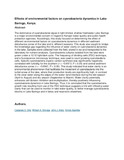| dc.contributor.author | Olilo, Casianes O. | |
| dc.contributor.author | Shivoga, William A. | |
| dc.contributor.author | Kitetu, John J. | |
| dc.contributor.author | Agembe, Simon | |
| dc.date.accessioned | 2021-07-09T10:30:24Z | |
| dc.date.available | 2021-07-09T10:30:24Z | |
| dc.date.issued | 2014-12-10 | |
| dc.identifier.uri | https://doi.org/10.1111/lre.12074 | |
| dc.identifier.uri | https://onlinelibrary.wiley.com/doi/full/10.1111/lre.12074 | |
| dc.identifier.uri | http://r-library.mmust.ac.ke/123456789/1769 | |
| dc.description.abstract | The dominance of cyanobacterial algae in light-limited, shallow freshwater Lake Baringo is a major environmental concern in regard to Kenyan water quality and public health protection agencies. Accordingly, this study focused on determining the effect of different environmental factors on cyanobacteria dynamics in different sediment disturbance zones of the lake and in different seasons. This study also sought to bridge the knowledge gap regarding the influence of water clarity on cyanobacteria dynamics in the lake. Samples were collected from the field, stored in ice and transported to the laboratory for nutrient analyses. Cyanobacteria cultures isolated from the lake were grown under a 12:12 light/dark cycle. The frequency of dividing cells (FDC) technique, and a fluorescence microscopy technique, was used to count growing cyanobacteria cells. Specific cyanobacteria organic carbon synthesis was significantly negatively correlated with turbidity for the southern (r = −0.6573; P < 0.05) and central sediment disturbance zones (r = −0.6847; P < 0.05). This study indicated that water clarity is an environmental phenomenon that facilitates the movement of cyanobacteria into the turbid areas of the lake, where their production levels are significantly high, in contrast to the clear water along the edges of the water–land interface during the wet season (April to August) and dry season (September to March). Water clarity potentially enhances cell division inhibition and multiplication, thereby positively influencing cyanobacteria dynamics in Lake Baringo. Thus, it is concluded that the cyanobacteria growth rate resulting from use of the FDC technique suggests a link with inflowing water clarity that can be used to monitor in-lake water quality, to better manage cyanobacteria blooms in Lake Baringo and in lakes and reservoirs elsewhere. | en_US |
| dc.language.iso | en | en_US |
| dc.publisher | Wiley Online Library | en_US |
| dc.subject | Effects, environmental, factors, cyanobacteria, dynamics, | en_US |
| dc.title | Effects of environmental factors on cyanobacteria dynamics in Lake Baringo, Kenya | en_US |
| dc.type | Article | en_US |

